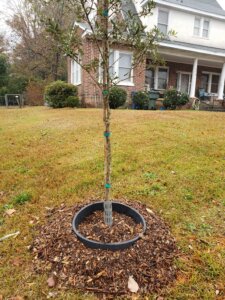
Winter Landscape Maintenance
It may seem like winter is a boring time in the landscape, but now is a great time to get a jump on gardening activities.
Trees
Arborists recommend planting trees now, after the leaves have dropped and tops are dormant. Winter planting gives the roots of the tree, which are still active, time to start growing before the tree has to shift all its resources to leaf production. Plant trees now, and remember to water daily for the first two weeks. Continue watering every other day for two months and then weekly for the next two years. Trees are a long-term commitment and need care just like shrubs and flowering plants.
Winter is a great time to prune trees, since the bare limbs make it easy to see the structure of the tree. Prune only as necessary, to remove any dead or crossing branches, diseased wood, or for structure. Topping crepe myrtles, also known as “crepe murder”, is not recommended. It stresses the trees and makes them more susceptible to disease. The resulting new growth is weaker and is less able to support the weight of leaves and flowers, especially when loaded down with rainwater from one of our summer storms.
Shrubs
Grassy Ground Covers and PerennialsWhile it’s not necessary to cut back ornamental grasses and grassy ground covers (like Liriope), now is a good time to do it if you want a nice, manicured look. Prune back grasses by cutting them about 4″-6″ above the ground just before the new growth begins to emerge. Usually that means pruning in late February or early March. Trimming them will help remove the old ragged growth and provide a fresh start come spring. Perennials can be trimmed back now, too, in preparation for spring growth.
Turf
Mulch
Since Columbia’s summers can be sweltering, why not take advantage of cooler temperatures now and get a head-start on one of gardening’s least appealing chores: adding mulch to your beds. Apply a 2″-3″ layer of your favorite mulch to help build the organic content of your soil and increase soil water retention. Keep mulch about 6″ from the trunk of trees to reduce the amount of water directly in contact with the tree’s trunk and discourage our wood-loving insects.